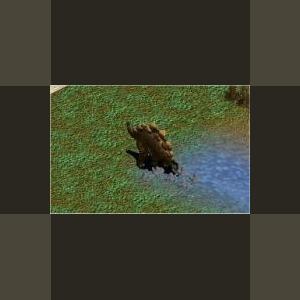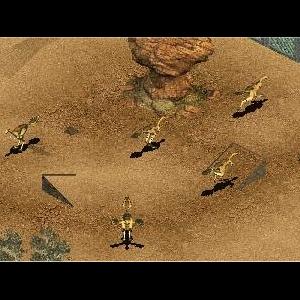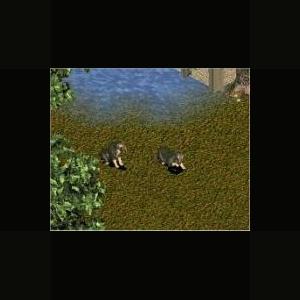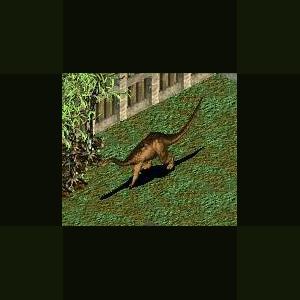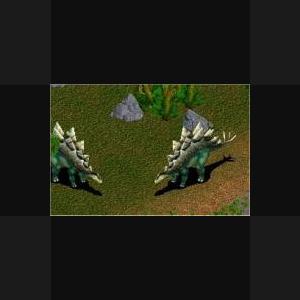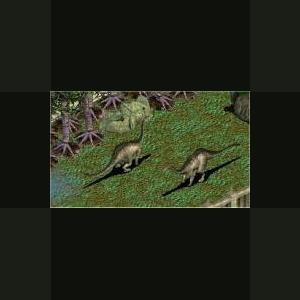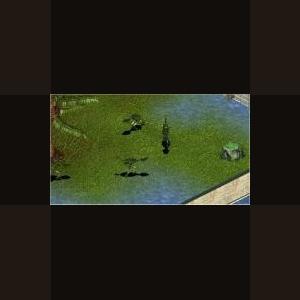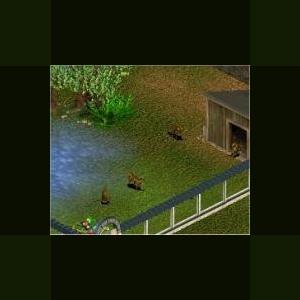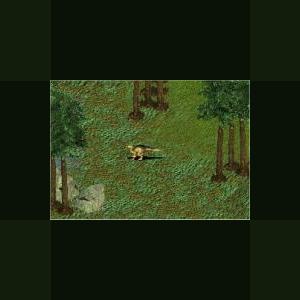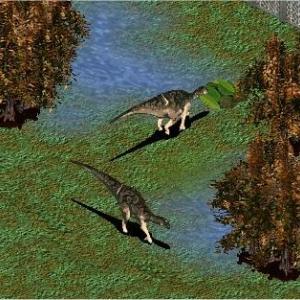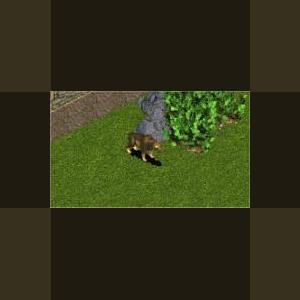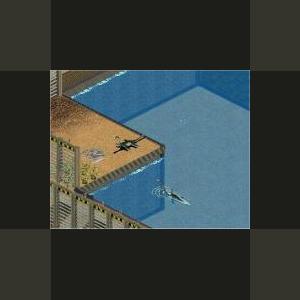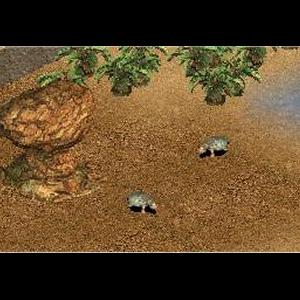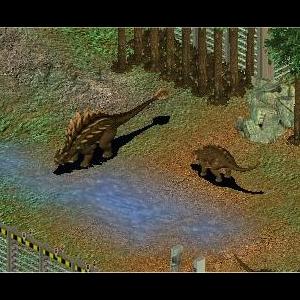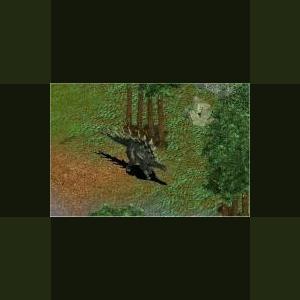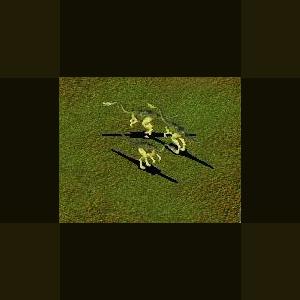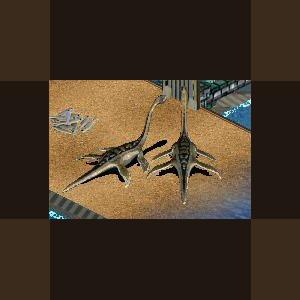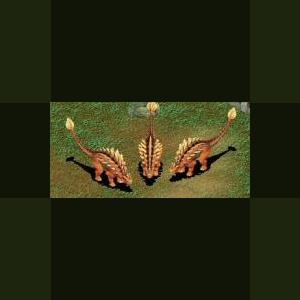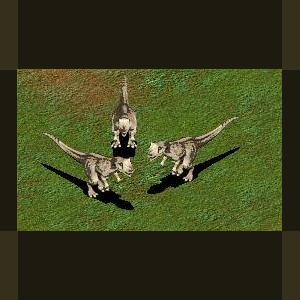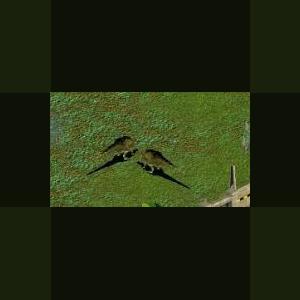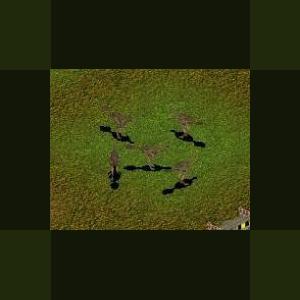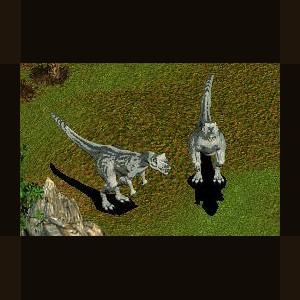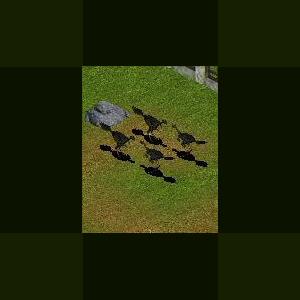Dinosaurs
Creatures from another age
241 files
-
Hesperosaurus by Ghirin
By Guest
Hesperosaurus by Ghirin
Hesperosaurus ("Western Lizard") is the oldest known genus of stegosaur in North America.
Reference:
The Illustrated Encyclopedia of Dinosaurs by Dougal Dixon. 2006
191 downloads
0 comments
Updated
-
Shuvuuia by Ghirin
By Guest
Shuvuuia was a member of the bird-like alvarezsaurid group. A distinguishing feature of this group was the short arm ending in a large claw. This might be an adaptation for digging for food.
Reference:
The Illustrated Ecyclopedia of Dinosaurs by Dougal Dixon. 2006
www.wikipedia.com
Created by Ghirin 2006
237 downloads
0 comments
Updated
-
Xenosmilus by Ghirin
By Guest
Xenosmilus by Ghirin
Xenosmilus ("Strange knife") is a relatively newly described genus of saber-toothed cat.
This genus has one species, X. hodsonae, and the fossils were found in a limestone quarry in Florida.
Xenosmilus lived about 1 million years ago. It was a heavily built feline approximately the size of a lion. The upper canine teeth were relatively short and broad.
References:
www.wikipedia.org
http://www.messybeast.com/cat-prehistory.htm
http://www.niu.edu/pubaffairs/NT/1999/march22/saber.html
266 downloads
0 comments
Updated
-
Efraasia by Ghirin
By Guest
Efraasia (named in honor of Eberhard Fraas) was a prosauropod discovered in Triassic deposits from Germany.
*Inspired by the Zoo Tycoon Brains Trust at the Zoo Tek Forums*
172 downloads
0 comments
Updated
-
Mbielu-Mbielu-Mbielu by Ghirin
By Guest
Mbielu-mbielu-mbielu by Ghirin
The name Mbielu-mbielu-mbielu means "the animal with planks growing out of its back."
This cryptid is from the Likouala swamp region of the Republic of Congo. The exact nature of Mbielu-mbielu-mbielu is unknown. Some think that it is similar to a stegosaur while others think that the cryptid is snake-like.
References:
www.wikipedia.org
http://www.cryptozoology.net/english/afric...u/overview.html
*Inspired by Professor Paul's Nature Encyclopedia*
176 downloads
0 comments
Updated
-
Riojasaurus by Ghirin
By Guest
Riojasaurus ("Rioja lizard") was a prosauropod dinosaur from Argentina. The remains were found in La Roja Province. It was a heavily built animal.
Reference:
www.wikipedia.org
Created by Ghirin 2008
147 downloads
0 comments
Updated
-
Anatotitan by Ghirin
By Guest
Anatotitan
Author: Ghirin
Anatotitan ("Giant Duck") was a large flat-headed hadrosaur from North America. In older literature, Anatotitan was listed as Anatosaurus or Trachodon.
*Inspired by the Zoo Tycoon Brain Trust at the Zoo Tek Evolved Forums
475 downloads
0 comments
Updated
-
Protarcheopteryx by Ghirin
By Guest
Protarcheopteryx
Author: Ghirin
Protarcheopteryx ("Before Archeopteryx") was a feathered dinosaur from the Cretaceous lakeside environment of Liaoning, China. It was a contemporary of Caudipteryx.
190 downloads
0 comments
Updated
-
Aegyptopithecus by Ghirin
By Guest
Aegyptopithecus by Ghirin
Aegyptopithecus was an early hominid that lived in what is now modern day Egypt.
At that time, Egypt was much more wet and humid.
Reference:
http://www.johnhawks.net/weblog/fossils/ap...egyptopithecus/
256 downloads
0 comments
Updated
-
Othnielia by Ghirin
By Guest
Othnielia Author: Ghirin
Othnielia, a small ornithopod dinosaur, was named in honor of paleiotologist Othniel Charles Marsh.
*Inspired by the Zoo Tycoon Brains Trust at the Zoo Tek Evolved Forums.
169 downloads
0 comments
Updated
-
Tanius by Ghirin
By Guest
Tanius Author: Ghirin
Tanius ("After Tan") is a genus of hadrosaur from China. The original specimen was collected by the Chinese geologist H. C. Tan and was named after him.
*Inspired by the Zoo Tycoon Brains Trust at the Zoo Tek Evolved Forums.*
148 downloads
0 comments
Updated
-
Barbourofelis Fricki by Ghirin
By Guest
Barbourofelis fricki
Author: Ghirin
Barbourofelis fricki ("Barbour's Cat") was a lion-sized member of the genus Barbourofelis from the family Nimravidae. Even though Barbourofelis strongly resembled the saber-toothed cats, the nimravids are no longer considered to be true felines due to distinct anatomical differences and are sometimes referred to as paleo-sabers or false saber-toothed cats.
Barbourofelis fricki was one of the last of the genus and roamed the North American grasslands approximately 6 million years ago.
285 downloads
0 comments
Updated
-
Cryptocleidus by Ghirin
By Guest
Cryptocleidus Author: Ghirin
Cryptocleidus ("Hidden Collar Bone") was a genus of plesiosaur from the late Jurassic period. Its fossils were found in Europe.
*Inspired by the Zoo Tycoon Brains Trust at the Zoo Tek Evolved Forums.
290 downloads
0 comments
Updated
-
Proganochelys by Ghirin
By Guest
Proganochelys by Ghirin
Proganochelys, the earliest known member of the tortoise family, lived in Europe during the Triassic period.
Its body is very similar to that of modern land tortoises, but Proganochelys could not retract its head or legs into its shell.
Reference:
The Simon and Schuster Encyclopedia of Dinosaurs and Prehistoris Creatures. Cox, Savage, Gardiner, Harrison, and Palmer, 1999.
229 downloads
0 comments
Updated
-
Cretoxyrhina by Ghirin
By Guest
Cretoxyrhina mantelli
Author Ghirin
The genus Cretoxyrhina was a member of the lamniform sharks from the late Cretaceous period. Its remains, mainly teeth, have been found worldwide. A large species, C. mantelli, has been found in what was the interior seaway of North America. It was similar in size to the modern great, white shark, but was not a close relative.
Like the modern great white shark, C. mantelli was an apex predator, feeding on marine reptiles such as moasaurs. The shark was nicknamed Ginsu due to the damage inflicted on its prey
395 downloads
0 comments
Updated
-
Euplocephalus by Ghirin
By Guest
Euplocephalus ("Well Armored Head") was a large ankylosaur from the Cretaceous period of North America.
It is one of the best known genera of this dinosaur group, with 40 known specimens.
Reference:
The Illustrated Encylopedia of Dinosaurs by Dougal Dixon. 2006
www.wikipedia.com
*Inspired by the Zoo Tycoon Brains Trust at the Zoo Tek Evolved Forums
223 downloads
0 comments
Updated
-
Lexovisaurus by Ghirin
By Guest
Lexovisaurus by Ghirin
Lexovisaurus ("Lizard of the Lexovi Tribe") lived on the islands found in the western portion of the Tethys Sea.
Reference:
www.wikipedia.org
167 downloads
0 comments
Updated
-
Liliensternus by Moondawg
By Guest
Liliensternus was a genus of coelophysoid dinosaur from the Late Triassic period, between about 215-200 mya.
Liliensternus was originally found in 1934 in Germany and was named after the German scientist, Dr. Hugo Rühle von Lilienstern. Liliensternus was around 6 meters long and may have preyed on herbivores like Plateosaurus. It probably weighed around 400 kilograms.
The type species is Liliensternus liliensterni. A second species, Liliensternus airelensis, which had an extra pair of cervical pleurocoels, is now considered a separate genus, Lophostropheus.
131 downloads
0 comments
Updated
-
Futabasaurus Suzukii by Moondawg
By Guest
Futabasaurus Suzukii is the name of a plesiosaur that was described in 2006 by Sato, Hasegawa, and Manabe.
Futabasaurus comes from the Late Cretaceous of Fukushima, Japan, and was assigned to the family Elasmosauridae.
The name Futabasaurus also appears in connection with a theropod dinosaur, also from the Late Cretaceous of Japan. However, this dinosaur was not officially named, so the name Futabasaurus is a nomen nudum when applied to this theropod. It is not the same as the plesiosaur named Futabasaurus.
342 downloads
0 comments
Updated
-
Euoplocephalus by Moondawg
By Guest
It has been said that the herbivores and carnivores forced each other to evolve in a rapid escalating battle of armor vs. firepower.
If this is the case, and it seems very likely it is, then a very successful biological armored vehicle was Euoplocephalus.
Pronounced you-op-luh-SEF-uh-lus the name means "well protected head. This tank-like creature was from the late Cretaceous and is in the Ankylosaur family. It was believed to weigh in the 3 to 5 ton range and averaged 20 feet in length and maybe 8 or 9 feet in width.
What is unusual is that this heavily armored dinosaur was very likely totally immune to the attack of the large carnivores like T rex. It's strategy may well have been to first try and use it's bony and spiked tail to dissuade its attacker and then if that didn't work to simply hanker down in the sand or earth, protect its head and just out wait its adversary. As a side note there have been T rex leg bones found that were fractured in just the manner that Euoplocephalus would have done if it connected in a fight.
This species was the long end product of a very successful weeding out of less successful creatures. If it was for the Extinction Event that took out all of the dinosaurs this creatures descendants may well have been alive to this day. That is if the plants continued to survive. At this time (app. 70 MYA) we would have found cycads, tree ferns, bonze pines, katsura trees, and large conifers. but perhaps the defining tree would have been the bald cypress. These plants only thrived in humid and warm conditions and this is where these armored dinosaurs would have flourished.
Inspired by the Zoo Tek Brains Trust
230 downloads
0 comments
Updated
-
Megaraptor by Moondawg
By Guest
Megaraptor ("giant thief") was once thought to be the largest dromaeosaur ever found, but is now known to be a carnosaur related to Allosaurus.
It lived in Late Cretaceous times in the Patagonian region of Argentina. It was a contemporary of Giganotosaurus, one of the largest carnivorous dinosaurs of all time.
Megaraptor was initially described as a giant dromaeosaur, known primarily from a single claw (about 1ft long) that resembled the sickle-shaped foot claw of dromaeosaurids. The discovery of a complete front limb, however, showed that this giant claw actually came from the first finger of the hand. The hands were unusually elongated, bore sickle-shaped claws even more recurved than those of spinosaurids.The hand is quite distinct from other basal tetanurans, so it is not clear whether Megaraptor is an allosaurid, a carcharodontosaurid, a spinosauroid, or something else entirely.
It should be noted that, when first discovered and prior to publication, the spinosaurid Baryonyx was also reported to be a dromaeosaurid, again based on a large hand claw.
Megaraptor's size is debated. However, most experts have come to agree that Megaraptor is approximately 8 meters (26 feet) in length and 3 meters (10 feet) in height.
179 downloads
0 comments
Updated
-
Hadrosaurus by Moondawg
By Guest
Hadrosaurus (hadros + sauros = sturdy lizard) is a dubious genus of hadrosaurid dinosaur.
In 1858, a skeleton of a dinosaur from this genus was the first full dinosaur skeleton found in North America and, in 1868, it became the first ever mounted dinosaur skeleton. Hadrosaurus foulkii is the only species in this genus and has been the official state dinosaur of New Jersey since 1991.
Hadrosaurus lived near what is now the coast of New Jersey, U.S.A., in the late Cretaceous Period - around 80 million years ago. It was likely bipedal for the purposes of running, but could use its forelegs to support itself while grazing - like all hadrosaurids, Hadrosaurus was herbivorous. Its teeth suggest it ate twigs and leaves
Hadrosaurus lived near what is now the coast of New Jersey, U.S.A., in the late Cretaceous Period - around 80 million years ago. It was likely bipedal for the purposes of running, but could use its forelegs to support itself while grazing - like all hadrosaurids, Hadrosaurus was herbivorous. Its teeth suggest it ate twigs and leaves.
In 1838, William Estaugh Hopkins was digging in a marl pit (on a small tributary of the Cooper River in Haddonfield, New Jersey) when he uncovered large bones, putting them on display at his home, also in Haddonfield. In 1858 these bones sparked the interest of a visitor, William Parker Foulke. The skeleton was dug out from the marl pit in 1858 by Foulke. In the same year, the species was named by paleontologist Joseph Leidy from an almost complete set of limbs, along with a pelvis, several part of the feet, twenty-eight vertebrae (including eighteen from the tail), eight teeth and two small parts of the jaw. Leidy recognized that these bones were from a dinosaur by their similarity to those of Iguanodon, discovered in England some decades before, but the skeleton of Hadrosaurus was far more complete. Leidy's monograph Cretaceous Reptiles of the United States, describing Hadrosaurus more completely and with illustrations, was written in 1860 but the American Civil War delayed its publication until 1865. Leidy reconstructed Hadrosaurus as a biped, in contrast to the view at the time that such dinosaurs were quadrupedal. The entire skeleton was completely assembled in 1868 by a team including English sculptor and naturalist Benjamin Waterhouse Hawkins and was put on display at Philadelphia Academy of Natural Sciences, where it remains available for public viewing.
248 downloads
0 comments
Updated
-
Beipiaosaurus by Moondawg
By Guest
Beipiaosaurus is a genus of therizinosauroid theropod dinosaur.
The discovery of Beipiaosaurus , which translates as "Beipiao lizard" after a city in China near the location of its discovery, was announced in the May 27, 1999, issue of the journal Nature. These fossils were found in Liaoning Province, China and have been dated to the early Cretaceous Period, about 125 million years ago. It is known from a single species, B. inexpectus, named for "the surprising features in this animal.". A significant number of fossilized bones for this species were recovered, including: cranial fragments, a mandible, three cervical vertebrae, four dorsal vertebrae, a caudal vertebra, the scapula and scapulacoracoid, a complete forelimb, and a complete pelvis with hindlimb.
The exact classification of therizinosaurs had in the past been hotly debated, since their prosauropod-like teeth and body structure indicate that they were generally herbivorous, unlike typical theropods. Beipiaosaurus, being considered to be a primitive therizinosauroid, has features which suggest that all therizinosauroids, including the more derived Therizinosauridae, to be coelurosaurian theropods, not sauropodomorph or ornithischian relatives as once believed.
Beipiaosaurus measured 2.2 meters (7.3 ft) in length and .88 meters (2.9 ft.) tall at the hip, and is among the largest known feathered dinosaurs. Its weight is estimated as about 85 kg (187 lb.) Beipiaosaurus had a toothless beak with cheek teeth. More advanced therizinosaurids have four functional toes, but the feet of Beipiaosaurus' have reduced inner toes, showing that the derived therizinosaurid condition may have evolved from a three-toed therizinosauroid ancestor. The head was large relative to other therizinosaurs, and it had some features similar to the related oviraptorosaurs. The fossil's skin impressions indicate its body was covered by downy feather-like fibers, which are similar to those of Sinosauropteryx, but longer, and are oriented perpendicular to the arm. Xu et al. suggest that the feathers of Beipiaosaurus represent an intermediate stage between Sinosauropteryx and more advanced birds (Avialae). As only theropod dinosaurs are so far known to have been feathered, this discovery is further evidence that therizinosaurs were indeed theropods.
214 downloads
0 comments
Updated
-
Giganotosaurus by Moondawg
By Guest
Giganotosaurus (meaning 'giant southern lizard', derived from the Ancient Greek gigas meaning 'giant', notos meaning 'south wind' and saurus meaning 'lizard') was a genus of carcharodontosaurid dinosaur that lived 93 to 89
Giganotosaurus carolinii was named for Ruben Carolini, an amateur fossil hunter, who discovered the fossils in the deposits of the Rio Limay Formation of Patagonia, southern Argentina, in 1993. It was published by Rodolfo Coria and Leonardo Salgado in the journal Nature in 1995.
The holotype specimen's (MUCPv-Ch1) skeleton was about 70% complete and included the skull, pelvis, leg bones and most of the backbone. It is estimated around 12.2-12.5 m (40-41 ft) in length. A second specimen , 8% larger, has also been recovered. This largest Giganotosaurus specimen is estimated to represent an individual 13.2 m (43.3 ft) long, that weighed 6.2 tons. Giganotosaurus might have had the longest known skull for a theropod dinosaur, with the holotype's skull estimated at 1.80 m (6 ft) and the second specimen's estimated at 1.95 m (6.3 ft).[6] Giganotosaurus surpasses Tyrannosaurus rex in length by almost a meter (the upper length estimate for T. rex is 13 m).
Giganotosaurus, along with relatives like Tyrannotitan, Mapusaurus and Carcharodontosaurus, are members of the carnosaur family Carcharodontosauridae. Both Giganotosaurus and Mapusaurus have been placed in their own subfamily Giganotosaurinae by Coria and Currie in 2006 as more carcharodontosaurid dinosaurs are found and described, allowing interrelationships to be calculated
G. carolinii was slightly larger than T. rex but had a much smaller brain that was the size and shape of a banana. Its teeth were built more for cutting and slicing rather than crushing bones. A well-developed olfactory region means that it probably had a good sense of smell. Its skull, although large, had a slender build.
355 downloads
Updated
-
Hagryphus by Moondawg
By Guest
Hagryphus
Hagryphus ("Ha's griffin", from Egyptian Ha, name of a god of the western desert and Greek gryphus meaning 'griffin' (a mythological bird-like creature); Zanno and Sampson, 2005) is an oviraptorosaurian theropod dinosaur from the Upper Cretaceous Period of what is now Utah.
To date, only a single species is known, H. giganteus. The holotype was discovered in the Kaiparowits Formation (Late Campanian) in the Grand Staircase-Escalante National Monument of southern Utah. Radiometric dating indicates that the beds where the specimen was found date to between 76 and 75 million years ago. Designated UMNH VP 12765, the type specimen resides in the collections of the Utah Museum of Natural History in Salt Lake City. It consists of an incomplete but articulated left manus and the distal portion of the left radius. Both the semilunate and radiale are preserved.
Other known species of North American oviraptorosaurs include Elmisaurus rarus, Microvenator celer, and Chirostenotes pergracilis. This group of dinosaurs is better known from the Cretaceous of Asia, where forms such as Khaan mckennai, Conchoraptor gracilis and Oviraptor philoceratops have been discovered.
Oviraptorosaurs are characterized by a shortened snout, massive endentulous jaws and extensively pneumatized skulls, often sporting elaborate crests, the function of which remains unknown. The toothless jaws may indicate a diet of eggs but these theropods likely fed on small vertebrates as well. Evidence suggests that they were feathered and some paleontologists consider them to be true birds (see the main article Oviraptorosauria for further information).
As the species name indicates, Hagryphus giganteus was a particularly large oviraptorosaur, estimated to have been approximately 3 meters (10 ft) long, which makes it one of the largest members of the clade Oviraptorosauria (Barsbold, 1976). H. giganteus is estimated to be 30-40% larger than the next largest known North American oviraptorosaur, Chirostenotes.
172 downloads
0 comments
Updated

